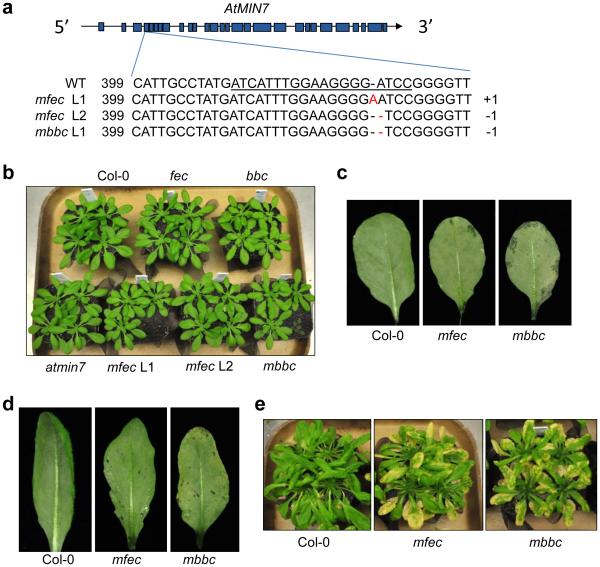Extended Data Figure 7.
Construction and characterization of the mfec and mbbc quadruple mutants. a, CRISPR-Cas9-mediated mutations in the 4th exon of the MIN7 gene (exons indicated by blue boxes) in the quadruple mutant lines used in this study. The underlined sequence in the wild type (WT) indicates the region targeted by sgRNA. The number “399” indicates the nucleotide position in the MIN7 coding sequence. “+1” and −1” indicate frame shifts in the mutant lines. b, Col-0 and various mutants used in this study have similar growth, development and morphology. Four-week-old plants are shown. c, The mfec and mbbc plants show a tendency of developing sporadic water soaking under high humidity. Five-week-old regularly-grown (~60% relative humidity) Col-0, mfec and mbbc plants were shifted to high humidity (~95%) for overnight and pictures of mature leaves were taken after high humidity incubation. d, Even leaves of mfec and mbbc plants that do not have sporadic water-soaking have a tendency to develop some water soaking after hrcC− inoculation. Five-week old Col-0, mfec and mbbc plants were dip-inoculated with hrcC− at 1×108 cfu/ml, and kept under high humidity (~95%). Leaf pictures were taken 2 days post inoculation. Images were representative of leaves from at least four plants. e, The non-pathogenic hrcC− mutant causes significant necrosis and chlorosis in the quadruple mutant plants. Col-0, mfec and mbbc plants were dip-inoculated with the hrcC− strain at 1×108 cfu/ml. Pictures were taken 9 days post inoculation. This is one of the four independent experimental repeats of the results presented in Fig. 5b.

